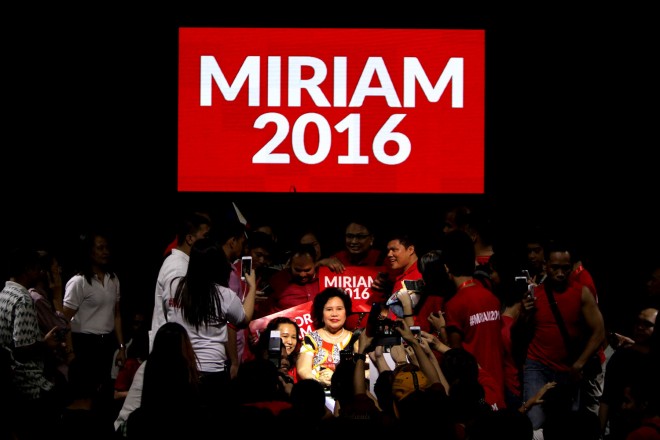
Senator and Presidential aspirant Miriam Defensor Santiago during the meet and greet of supporters at the UP Bahay ng Alumni in Quezon City. RICHARD A. REYES
Sen. Miriam Defensor-Santiago has high hopes that her support among the youth will propel her to victory in next year’s presidential race as young people, she said, looked beyond traditional politics.
Santiago emerged as the runaway winner in the Nov. 26 mock elections at the University of the Philippines Los Baños (UPLB), with 1,507 students, or 65.75 percent of the 2,292 student voters, voting her as President.
Davao City Mayor Rodrigo Duterte was a far second, with 18.32 percent of the votes.
The three other presidential candidates had voter shares of less than five percent: Liberal Party standard-bearer Mar Roxas (4.97 percent), Sen. Grace Poe (4.36 percent) and Vice President Jejomar Binay (2.01 percent). Other candidates, lumped together, took 3.49 percent, while 1.09 percent of respondents abstained from voting.
Santiago said the youth is an important sector as it comprises some 37 percent of eligible voters in 2016.
“The candidate with the greatest youth support has greater chances of winning not only because of the sheer size of the youth vote but also because of their persuasive power. People listen to the young because it is their future at stake,” Santiago said.
20-million strong
Some 54 million Filipinos are expected to vote next year, 20 million of them aged 18 to 35. That means that just 75 percent of the youth can give a candidate 15 million votes, close to the number that made President Aquino win in 2010.
Santiago said that her victory in the mock elections, despite the fact that she has yet to air campaign advertisements, validates the results of a Facebook-based survey where she also emerged the winner, with 48.36 percent of respondents favoring her.
“In the 1992 elections, the youth not only voted for me, they campaigned for me on a volunteer basis. This new generation seems ready to do the same through social media,” said the senator, who has some 3.2 million followers on Facebook and 2.1 million followers on Twitter.
The feisty senator, who trailed four other presidential candidates in a recent Metro Manila survey by Pulse Asia Research, said earlier that social media would be the key to winning the elections in 2016.
In the UPLB survey, only the students who are qualified to vote in the 2016 elections were allowed to participate in the mock polls. The respondents were also asked to write their student numbers to prevent double voting.
The UPLB poll followed the voting process in actual elections, said political science instructor Miguel Enrico Ayson. Voting booths were set up around the campus. As in the real elections, were given sample ballots and were told to shade the circle before the names of their preferred candidate.
Landslide winner
This is not the first UPLB mock poll that Santiago has won. She was also the landslide winner, with 57.44 percent of the total 1,170 votes cast in a May 2015 exercise conducted by a class of social psychology students.
Santiago was followed in that survey by Duterte (7.01 percent), Poe (5.56 percent), Sen. Chiz Escudero and former Sen. Dick Gordon (4.44 percent each), Binay (3.5 percent) and Sen. Alan Peter Cayetano (2.31 percent).
Santiago also topped a survey on the official Facebook fan page of the Polytechnic University of the Philippines, with 64 percent of the total 135,622 votes cast from Oct. 16, the deadline of filing of candidacy certificates, to Oct. 25.